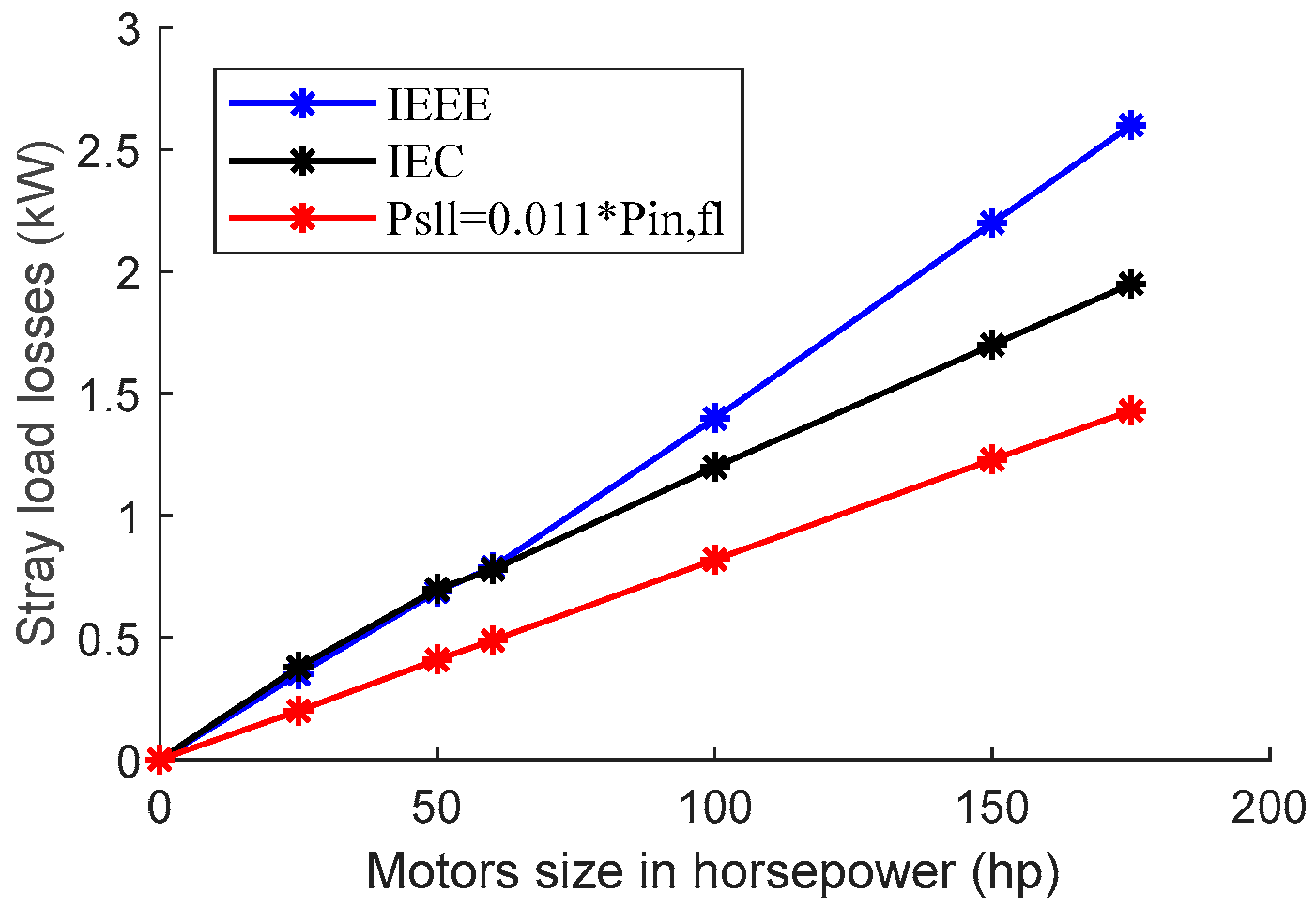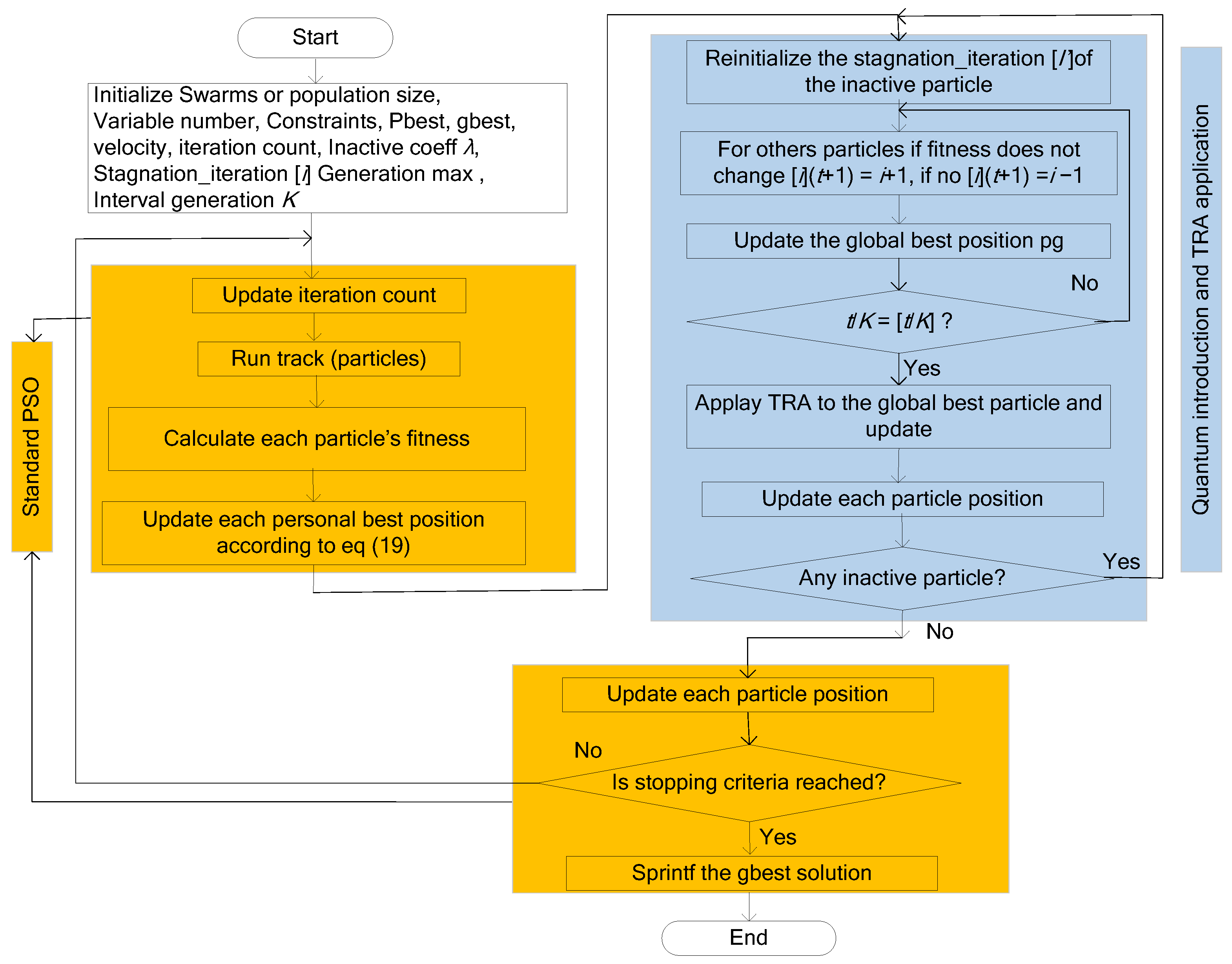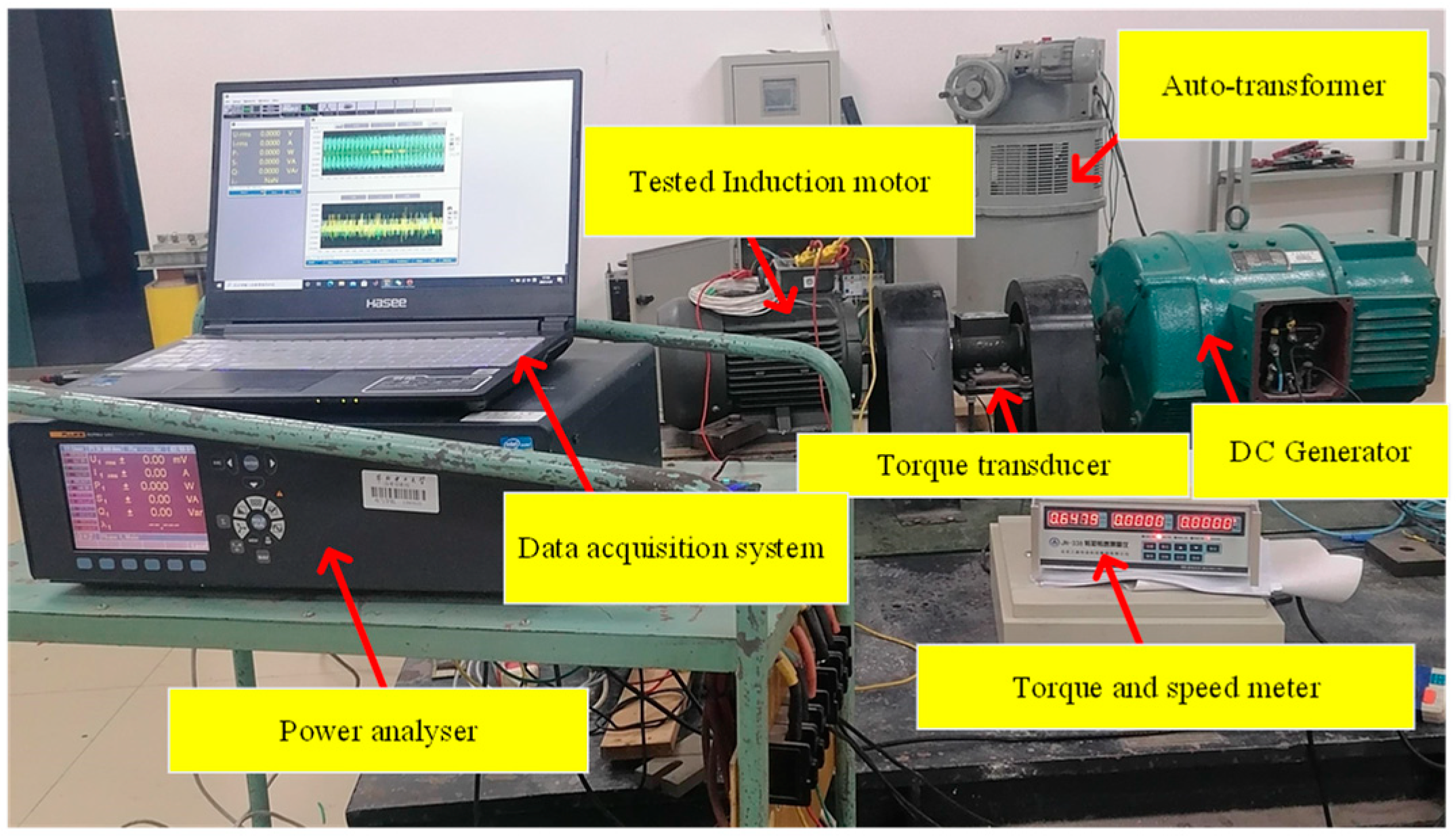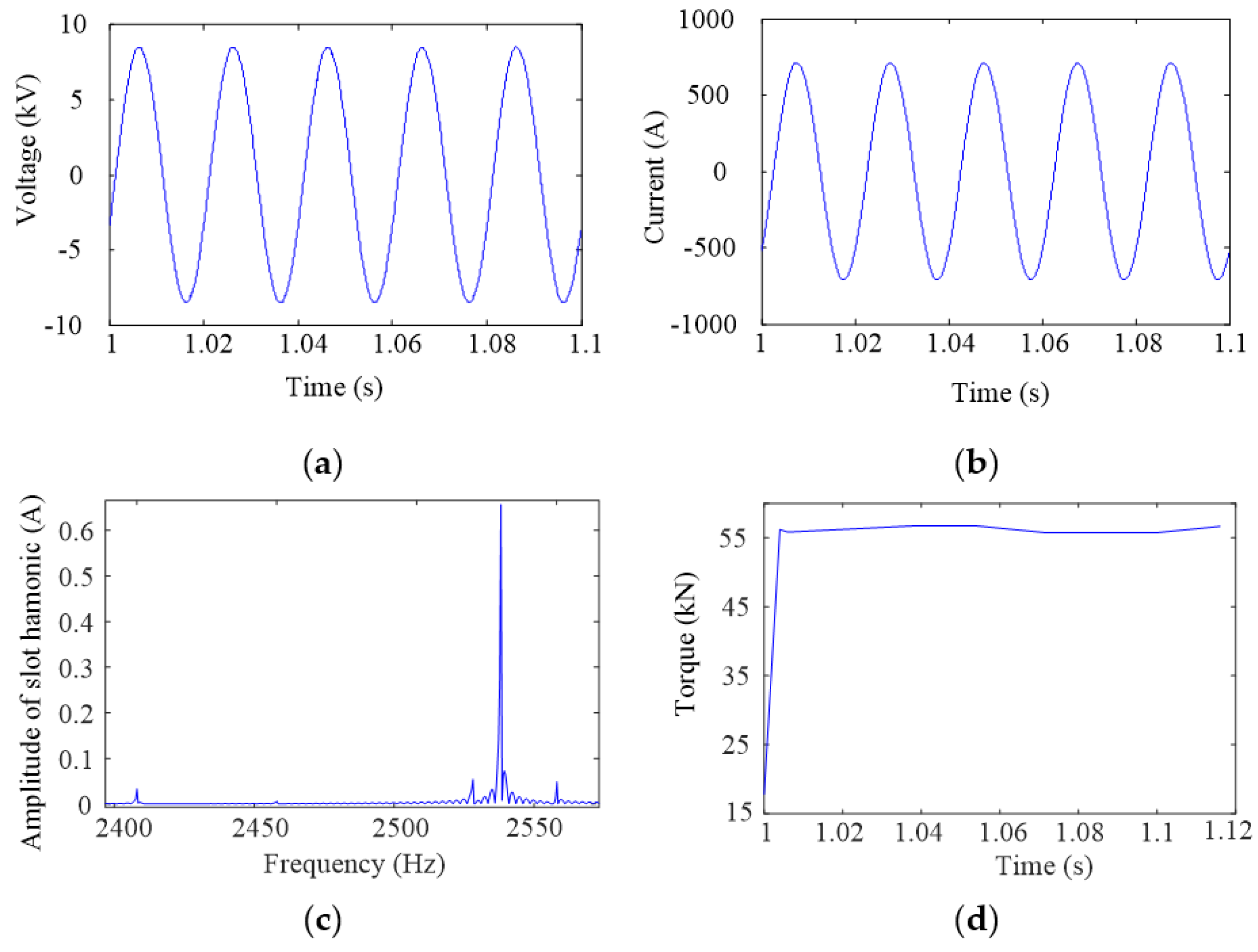In-Situ Efficiency Estimation of Induction Motors Based on Quantum Particle Swarm Optimization-Trust Region Algorithm (QPSO-TRA)
Abstract
1. Introduction
- (1)
- Slip methods;
- (2)
- Current methods;
- (3)
- Segregated loss method;
- (4)
- Equivalent circuit-based method;
- (5)
- Nonintrusive air gap torque (NAGT) methods;
- (6)
- Air gap torque (AGT) methods;
- (7)
- Shaft torque method.
2. Efficiency Estimation Method
2.1. Torque and Speed Determination Methods
2.2. Core Losses Determination
2.3. Stray Load Loss Determination
2.4. Friction and Winding (PFW) Losses Determination
- (a)
- If the number of poles is 2, then the friction and windage losses will be calculated using the Equation (12):
- (b)
- If the number of poles is 4, the friction and windage losses will be calculated by Equation (13).
- (c)
- If the number of poles is 6, the friction and windage losses can be calculated by Equation (14).
2.5. Output Torque and Efficiency Determination
2.6. Problems in Current Efficiency Determination
- (1)
- Rs and Rfe identification with higher precision is vital in all efficiency estimation processes. However, both of them are variants; the first one is a function of the operating condition and the second one is a function of the voltage condition. Therefore, identifying them in real time is essential for efficiency estimation.
- (2)
- A Genetic Algorithm (GA)’s computation time and burden are high. In [4], it is stated that three GAs were constructed to extract the necessary parameters; some versions of GA use binary coding [14], which demands significant time and computational space. The standard PSO is a global search algorithm. Despite having a fast and straightforward convergence, one of the drawbacks of this algorithm is its global research abilities. If the best particle is a local one in a PSO system, it cannot be accurately identified. In fact, in PSO, the particles will congregate near the global particles if the number of iterations increases.
3. Quantum Particles Swarm Optimization-Trust Region Algorithm (QPSO-TRA)
3.1. Standard Particle Swarm Optimization PSO
3.2. Quantum Particles Swarm Optimization (QPSO)
3.3. Trust Region Algorithm (TRA)
3.4. Hybrid Algorithm Formed by QPSO and TRA (QPSO-TRA)
4. Experimental Validation
4.1. Laboratory Test
4.2. Field Application
5. Conclusions
- (1)
- A new algorithm to identify the motor parameters is designed to deal with the problem mentioned early for induction motor parameters identification. This new algorithm is called QPSO-TRA. After comparing the extracted parameters with QPSO-TRA and standard PSO, it is found that QPSO-TRA can achieve a better result than the standard PSO, as can be seen in Table 3 and Table 5.
- (2)
- With the proposed hybrid algorithm, global research is avoided when investigating the full research space. The computation time and burden are reduced to 1/3 compared to the Genetic Algorithm and also the algorithm is faster, reducing the computational time, compared to simple TRA.
- (3)
- Experiments in the laboratory and the field were performed to analyze the performance of the proposed efficiency estimation algorithm by testing some induction motors of various types and rating power in the laboratory rather than in the field. The relative errors in Table 4 and Table 6 are less than 2%, which is a good indicator to show the high accuracy of the proposed method. Finally, the high accuracy level showed by the proposed technique validated the efficiency estimation technique.
Author Contributions
Funding
Institutional Review Board Statement
Informed Consent Statement
Data Availability Statement
Acknowledgments
Conflicts of Interest
References
- Gajjar, C.S.; Kinyua, J.M.; Khan, M.A.; Barendse, P.S. Analysis of a Nonintrusive Efficiency Estimation Technique for Induction Machines Compared to the IEEE 112B and IEC 34-2-1 Standards. IEEE Trans. Ind. Appl. 2015, 51, 4541–4553. [Google Scholar] [CrossRef]
- Esen, G.K.; Ozdemir, E. A New Field Test Method for Determining Energy Efficiency of Induction Motor. IEEE Trans. Instrum. Meas. 2017, 66, 3170–3179. [Google Scholar] [CrossRef]
- Santos, V.S.; Eras, J.J.C.; Gutierrez, A.S.; Ulloa, M.J.C. Assessment of the energy efficiency estimation methods on induction motors considering real-time monitoring. Energy Convers. Manag. 2019, 136, 237–2470. [Google Scholar] [CrossRef]
- Al-Badri, M.; Pillay, P.; Angers, P. A Novel In Situ Efficiency Estimation Algorithm for Three-Phase IM Using GA, IEEE Method F1 Calculations, and Pretested Motor Data. IEEE Trans. Energy Convers. 2015, 30, 1092–1102. [Google Scholar] [CrossRef]
- Hsu, J.S.; Sorenson, P.L. Field Assessment of Induction Motor Efficiency through Air-Gap Torque. IEEE Trans. Energy Convers. 1996, 11, 489–494. [Google Scholar] [CrossRef][Green Version]
- Bijan, M.G.; Al-Badri, M.; Pillay, P.; Angers, P. Induction Machine Parameter Range Constraints in Genetic Algorithm Based Efficiency Estimation Techniques. IEEE Trans. Ind. Appl. 2018, 54, 4186–4197. [Google Scholar] [CrossRef]
- Siraki, G.; Pillay, P. An in situ efficiency estimation technique for induction machines working with unbalanced supplies. IEEE Trans. Energy Convers. 2012, 27, 85–95. [Google Scholar] [CrossRef]
- Std 112-2004 (Revision IEEE Std 112-1996); IEEE Standard Test Procedure for Polyphase Induction Motors and Generators 2004. IEEE Press: Piscataway, NJ, USA, 2018; pp. 1–83.
- Hsu, J.; Scoggins, B. Field test of motor efficiency and load changes through air-gap torque. IEEE Trans. Energy Convers. 1995, 10, 477–483. [Google Scholar] [CrossRef]
- Santos, V.S.; Felipe, P.R.V.; Sarduy, J.R.G.; Lemozy, N.A.; Jurado, A.; Quispe, E.C. Procedure for Determining Induction Motor Efficiency Working Under Distorted Grid Voltages. IEEE Trans. Energy Convers. 2015, 30, 331–339. [Google Scholar] [CrossRef]
- Siraki, A.G.; Pillay, P.; Angers, P. Full Load Efficiency Estimation of Refurbished Induction Machines from No-Load Testing. IEEE Trans. Energy Convers. 2013, 28, 317–326. [Google Scholar] [CrossRef]
- Siraki, G.; Pillay, P. Comparison of two methods for full-load in situ induction motor efficiency estimation from field testing in the presence of over/undervoltages and unbalanced supplies. IEEE Trans. Ind. Appl. 2012, 48, 1911–1921. [Google Scholar] [CrossRef]
- Desai, C.; Pillay, P. Back EMF, torque-angle, and core loss characterization of a variable-flux permanent-magnet machine. IEEE Trans. Transp. Electrif. 2019, 5, 371–384. [Google Scholar] [CrossRef]
- Zhang, Z.; Deng, Z.; Sun, Q.; Peng, C.; Gu, Y.; Pang, G. Analytical Modeling and Experimental Validation of Rotor Harmonic Eddy-Current Loss in High-Speed Surface-Mounted Permanent Magnet Motors. IEEE Trans. Magn. 2018, 55, 100811. [Google Scholar] [CrossRef]
- Climente-Alarcon, V.; Antonino-Daviu, J.A.; Haavisto, A.; Arkkio, A. Diagnosis of Induction Motors Under Varying Speed Operation by Principal Slot Harmonic Tracking. IEEE Trans. Ind. Appl. 2015, 51, 3591–3599. [Google Scholar] [CrossRef]
- Silva, W.L.; Lima, A.M.N.; Oliveira, A. Speed Estimation of an Induction Motor Operating in the Nonstationary Mode by Using Rotor Slot Harmonics. IEEE Trans. Instrum. Meas. 2014, 64, 984–994. [Google Scholar] [CrossRef]
- Al-Badri, M.; Pillay, P.; Angers, P. A Novel in Situ Efficiency Estimation Algorithm for Three-Phase Induction Motors Operating with Distorted Unbalanced Voltages. IEEE Trans. Ind. Appl. 2017, 53, 5338–5347. [Google Scholar] [CrossRef]
- Stopa, M.M.; Resende, M.R.; Luiz, A.S.A.; Justino, J.C.G.; Rodrigues, G.G.; Filho, B.J.C. A Simple Torque Estimator for In-Service Efficiency Determination of Inverter-Fed Induction Motors. IEEE Trans. Ind. Appl. 2020, 56, 2087–2096. [Google Scholar] [CrossRef]
- Salomon, C.P.; Sant’Ana, W.C.; da Silva, L.E.B.; Lambert-Torres, G.; Bonaldi, E.L.; de Oliveira, L.E.L.; da Silva, J.G.B. Induction Motor Efficiency Evaluation Using a New Concept of Stator Resistance. IEEE Trans. Instrum. Meas. 2015, 64, 2908–2917. [Google Scholar] [CrossRef]
- Bramerdorfer, G.; Tapia, J.A.; Pyrhonen, J.J.; Cavagnino, A. Modern Electrical Machine Design Optimization: Techniques, Trends, and Best Practices. IEEE Trans. Ind. Electron. 2018, 65, 7672–7684. [Google Scholar] [CrossRef]
- Wang, P.-P.; Chen, X.-X.; Zhang, Y.; Hu, Y.-J.; Miao, C.-X. IBPSO-Based MUSIC Algorithm for Broken Rotor Bars Fault Detection of Induction Motors. Chin. J. Mech. Eng. 2018, 31, 80. [Google Scholar] [CrossRef]
- Liu, F.; Gao, J.; Liu, H. A Fault Diagnosis Solution of Rolling Bearing Based on MEEMD and QPSO-LSSVM. IEEE Access 2020, 8, 101476–101488. [Google Scholar] [CrossRef]
- Hu, C.; Reeves, S.J. Trust Region Methods for the Estimation of a Complex Exponential Decay Model in MRI With a Single-Shot or Multi-Shot Trajectory. IEEE Trans. Image Process. 2015, 24, 3694–3706. [Google Scholar] [PubMed]






| Machines Rating (kW) | Stray Load Loss Percent |
|---|---|
| 1–90 | 1.8% |
| 91–375 | 1.5% |
| 376–1850 | 1.2% |
| 1851 and greater | 0.9% |
| Design Class | X1/X2 |
|---|---|
| A | 1.00 |
| B | 0.67 |
| C | 0.43 |
| D | 1.00 |
| Wound rotor | 1.00 |
| Parameters | PSO | QPSO-TRA |
|---|---|---|
| R1 | 2.43 | 2.43 |
| R2 | 1.92 | 1.72 |
| Rfe | 2803.87 | 2687.675 |
| Xm | 114.15 | 150.003 |
| X1 | 0.88 | 0.85 |
| X2 | 1.31 | 1.27 |
| Load (%) | Speeds (r/min) | Relative Errors | Efficiencies (%) | Relative Errors PSO/QPSO-TRA | |||
|---|---|---|---|---|---|---|---|
| Measured | Estimated | Measured | Estimated | ||||
| PSO | QPSO-TRA | ||||||
| 100 | 1468.04 | 1465.71 | 0.0158 | 88.63 | 91.05 | 89.32 | 0.1900 |
| 75 | 1475.08 | 1473.88 | 0.0081 | 91.41 | 90.94 | 91.65 | −0.0780 |
| 50 | 1481.4 | 1482.5 | −0.0007 | 90.04 | 89.55 | 89.95 | −0.0446 |
| 25 | 1489.5 | 1490.8 | −0.0008 | 83.86 | 89.33 | 83.53 | 0.6492 |
| Parameters | 10 MW Motor | |
|---|---|---|
| QPSO-TRA | PSO | |
| R1 | 0.223 | 0.351 |
| R2 | 0.172 | 0.272 |
| Rfe | 28,687.675 | 29,381.178 |
| Xm | 2350.003 | 2715.078 |
| X1 | 0.115 | 0.231 |
| X2 | 0.115 | 0.231 |
| Measured Efficiency (%) | Estimated Efficiency by PSO (%) | Estimated Efficiency QPSO-TRA (%) | Relative Errors PSO/QPSO-TRA |
|---|---|---|---|
| 96.01 | 95.63 | 96.43 | 0.83 |
Publisher’s Note: MDPI stays neutral with regard to jurisdictional claims in published maps and institutional affiliations. |
© 2022 by the authors. Licensee MDPI, Basel, Switzerland. This article is an open access article distributed under the terms and conditions of the Creative Commons Attribution (CC BY) license (https://creativecommons.org/licenses/by/4.0/).
Share and Cite
Diarra, M.N.; Yao, Y.; Li, Z.; Niasse, M.; Li, Y.; Zhao, H. In-Situ Efficiency Estimation of Induction Motors Based on Quantum Particle Swarm Optimization-Trust Region Algorithm (QPSO-TRA). Energies 2022, 15, 4905. https://doi.org/10.3390/en15134905
Diarra MN, Yao Y, Li Z, Niasse M, Li Y, Zhao H. In-Situ Efficiency Estimation of Induction Motors Based on Quantum Particle Swarm Optimization-Trust Region Algorithm (QPSO-TRA). Energies. 2022; 15(13):4905. https://doi.org/10.3390/en15134905
Chicago/Turabian StyleDiarra, Mahamadou Negue, Yifan Yao, Zhaoxuan Li, Mouhamed Niasse, Yonggang Li, and Haisen Zhao. 2022. "In-Situ Efficiency Estimation of Induction Motors Based on Quantum Particle Swarm Optimization-Trust Region Algorithm (QPSO-TRA)" Energies 15, no. 13: 4905. https://doi.org/10.3390/en15134905
APA StyleDiarra, M. N., Yao, Y., Li, Z., Niasse, M., Li, Y., & Zhao, H. (2022). In-Situ Efficiency Estimation of Induction Motors Based on Quantum Particle Swarm Optimization-Trust Region Algorithm (QPSO-TRA). Energies, 15(13), 4905. https://doi.org/10.3390/en15134905








